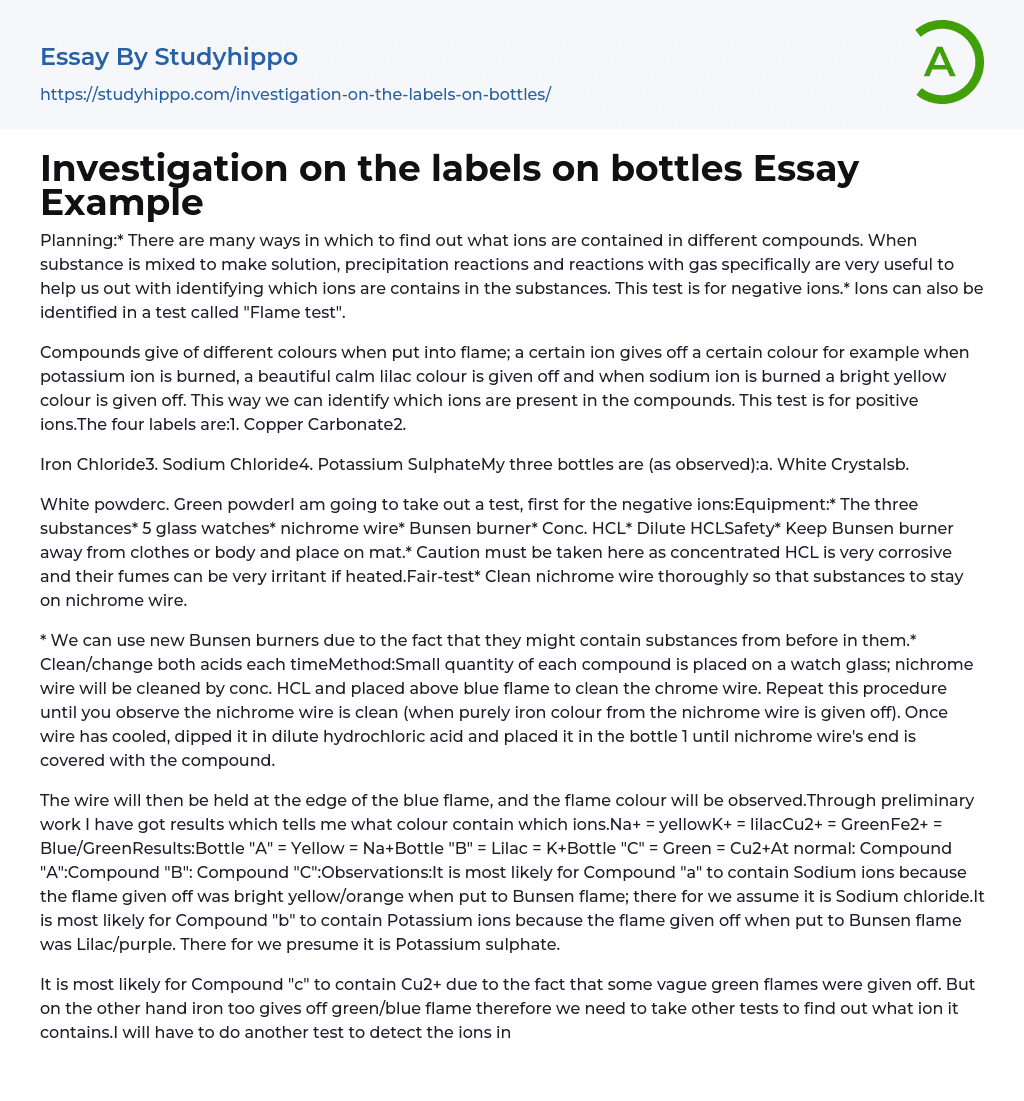Planning:
* There are many ways in which to find out what ions are contained in different compounds. When substance is mixed to make solution, precipitation reactions and reactions with gas specifically are very useful to help us out with identifying which ions are contains in the substances. This test is for negative ions.
* Ions can also be identified in a test called "Flame test".
Compounds give of different colours when put into flame; a certain ion gives off a certain colour for example when potassium ion is burned, a beautiful calm lilac colour is given off and when sodium ion is burned a bright yellow colour is given off. This way we can identify which ions are present in the compounds. This test is for positive ions.
The four labels are:
1. Copper Carbonate
2.Iron Chloride
3. Sodium Chloride
4. Potassium Sulphate
My three bottles are (a
...s observed):
a. White Crystalsb.
White powderc. Green powderI am going to take out a test, first for the negative ions:
Equipment:
* The three substances
* 5 glass watches* nichrome wire
* Bunsen burner
* Conc. HCL
* Dilute HCLSafety
* Keep Bunsen burner away from clothes or body and place on mat.
* Caution must be taken here as concentrated HCL is very corrosive and their fumes can be very irritant if heated.Fair-test
* Clean nichrome wire thoroughly so that substances to stay on nichrome wire.
* We can use new Bunsen burners due to the fact that they might contain substances from before in them.
* Clean/change both acids each timeMethod: Small quantity of each compound is placed on a watch glass; nichrome wire will be cleaned by conc. HCL and placed above blue flame to clean the chrome wire. Repeat this procedure until you observe
the nichrome wire is clean (when purely iron colour from the nichrome wire is given off). Once wire has cooled, dipped it in dilute hydrochloric acid and placed it in the bottle 1 until nichrome wire's end is covered with the compound.
The wire will then be held at the edge of the blue flame, and the flame colour will be observed.Through preliminary work I have got results which tells me what colour contain which ions.Na+ = yellowK+ = lilacCu2+ = GreenFe2+ = Blue/GreenResults:Bottle "A" = Yellow = Na+Bottle "B" = Lilac = K+Bottle "C" = Green = Cu2+At normal: Compound "A":Compound "B": Compound "C":Observations:It is most likely for Compound "a" to contain Sodium ions because the flame given off was bright yellow/orange when put to Bunsen flame; there for we assume it is Sodium chloride.It is most likely for Compound "b" to contain Potassium ions because the flame given off when put to Bunsen flame was Lilac/purple. There for we presume it is Potassium sulphate.
It is most likely for Compound "c" to contain Cu2+ due to the fact that some vague green flames were given off. But on the other hand iron too gives off green/blue flame therefore we need to take other tests to find out what ion it contains.I will have to do another test to detect the ions in the compounds and to prove the results for the previous tests. In order to do this I will do an anion test. I will have to find out whether it is Iron chloride or copper carbonate, so I will do two tests which are only for sulphate ions (SO4-) and carbonate anions (CO3-).Equipment
2
Test tube testube rack delivery tube bung lime water Substance "c" Dilute hydrochloric acidSafety Wear jacket and goggles for it may have a vigorous reaction, keep away from your body do not look over the test tubesMethod:For carbonate ions;Dilute HCL will be poured into a testube with a finger size amount ofSubstance "C", immediately it should be covered with a bung, connected to another test tube with limewater, the compound should react giving off a gas, which should change the lime water to a cloudy form.
Results:
We did not have enough lime water there for nothing much really happened to the lime water therefore we are trying another procedure.Method:Observations:Fortunately the red litmus paper did go blue this means that substance "c" contained CO2 and due to the presence of CO2 the red litmus paper turned blue and therefore this means the substance had a carbonate (negative ion). There fore it is a Copper Carbonate.
- Accounting essays
- Marketing essays
- Automation essays
- Business Cycle essays
- Business Model essays
- Business Operations essays
- Business Software essays
- Corporate Social Responsibility essays
- Infrastructure essays
- Logistics essays
- Manufacturing essays
- Multinational Corporation essays
- Richard Branson essays
- Small Business essays
- Cooperative essays
- Family Business essays
- Human Resource Management essays
- Sales essays
- Market essays
- Online Shopping essays
- Selling essays
- Strategy essays
- Management essays
- Franchising essays
- Quality Assurance essays
- Business Intelligence essays
- Corporation essays
- Stock essays
- Shopping Mall essays
- Harvard Business School essays
- Harvard university essays
- Trade Union essays
- Cooperation essays
- News Media essays
- Waste essays
- Andrew Carnegie essays
- Inventory essays
- Customer Relationship Management essays
- Structure essays
- Starting a Business essays
- Accounts Receivable essays
- Auditor's Report essays
- Balance Sheet essays
- Costs essays
- Financial Audit essays
- International Financial Reporting Standards essays
- Tax essays
- Accountability essays
- Cash essays
- Principal essays




